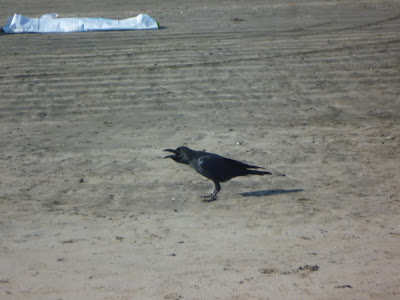Scroll down for English-language version
Antaŭ 10 tagoj mi revenis hejmen post tre ĝuinda kaj interesa vojaĝo al Japanio. Tuj post mia reveno mi suferis pro horzonozo, kaj tiam, kiam mi vekiĝis post kelktaga dormeto mi trovis problemon en la domo; akvogutoj fluetis de la akvoboligilo por mia centra hejtada sistemo!
Finfine hieraŭ ĉio ripariĝis kaj por la unua fojo post mia reveno mi havas la tempon iomete verki pri mia vojaĝo.
Estis mia kvara vizito al Japanio - iuj el vi jam scias ke la filino de Pudingulo (mia koramiko) loĝas tie ekde jam kelkaj jaroj. Ĉi-foje ni restis en Tokio, pli esploris la ĉefurbon kaj faris kelkajn tagekskursojn al aliaj lokoj.
Ĉi-sube estas ne tre klara foto de strato apud mia hotelo en
Ŝinĝuku. Kvankam ne bonegega foto, montras iomete la etoson.
Multe plaĉas al mi Tokio. Plaĉas al mi urbegoj, sed ne tro da bruo. Kaj fakte, kvankam tio eble surprizigus vin, mi trovas ke Tokio estas sufiĉe kvieta urbego. Se oni piediras tra eĉ malgranda urbo en Britio, ekzemple Kardifo kie mi loĝas, estas ĉiam multe da bruo; aŭtoŝoforoj laŭte hupadas senĉese kaj pliigas la motoron de iliaj aŭtoj kiam ili atendas ĉe semaforoj ktp.
Ebriuloj laŭte krias surstrate kaj eĉ dumtage oni krias, laŭte alvokas, brue babiladas.
Ege surprizige, kvankam pli da homoj ĉiutage trapasas la stacidomon Ŝinĝuku ol ekzistas en mia lando Kimrio, estas multe malpli brua. En kafejoj kaj restoracioj oni babiladas pli kviete kaj la ĝenerala etoso estas multe pli trankvila.
Jen la perspektivo el mia hotela ĉambro. Por tiuj kiuj ŝatas ferii en la kamparo, ŝajnos neeble mi supozas ke mi tiom ĝojas vidi tiom da konstruaĵoj. Nu, ni ĉiuj malsimilas ĉu ne?
Noto: Vi rimarkos ke malkiel kutime, mi aldonas resumon ĉi-sube en la angla lingvo. Kelkaj familianoj petis ke mi tion faru ĉi-foje ĉar ili ankoraŭ ne konsentis lerni Esperanton. Notu, tamen, ke ne estas traduko de la Esperantlingva versio, simple ĉar estas enuiga verki la saman aferon dufoje!
At the request of some of my non-Esperanto-speaking friends and family members, I'm adding an English-language text to my posts about my recent Japan trip. Don't expect this to be a direct translation of the above - way too boring to write the same thing twice in different languages. It will be a summary covering most of the same points...
So, having got over my jet lag and having finally sorted out my leaking boiler (discovered on arrival home last week) I now have hot water, heating and am conscious enough to put up a few photos about my trip.
The top photo isn't very clear, but gives you a bit of a representation of the nighttime atmosphere in
Shinjuku. The video clip is the view from the hotel window.
Most of my readers know that I'm a total city girl and I love being in the middle of Tokyo with the city hustle and bustle. You might be surprised though, as many of my Japanese friends are when I tell them this, that Tokyo is a very quiet city. When you think that more people pass through Shinjuku station in a day than make up the entire population of Wales, that seems like a crazy thing to say, but it really is my impression.
Even in a small city like Cardiff, you have the constant beeping of car horns, revving of engines and general noise. Even in the busiest parts of Tokyo you have very little of that ambient noise. The general noise level that you get in the city centre of Cardiff, let alone the shouting, people shrieking and overall hubbub is much louder than in any Japanese city. In cafes, restaurants, any background music is audible, but unobtrusive and conversation takes place quietly. I'm sure that there are bars where on a Saturday night you'll have a much louder noise level, but generally it's lovely to have far fewer assaults on your ears and much less need to shout to make yourself heard than here in the UK. Nasty shock when we get back off the plane at Heathrow though :(









